Tortoise Poaching in Galápagos
November, 2000: giant tortoises are threatened by fishing interests
A splinter group of fishermen in the Galapagos islands recently stole baby giant tortoises from the Isabela island captive breeding center. The fishermen's implied threat was to slaughter the tortoises if the government of Ecuador failed to give in to their demands to extend fishing limits. Meanwhile, a lawless mob sacked Galapagos National Park Service and Charles Darwin Research Station offices on Isabela island and chased conservation personnel into the mangroves bordering the tiny fishing port of Puerto Villamil.
Threatening Galapagos tortoises has been a standard political ploy in this province of Ecuador since at least 1992: "Give us what we want (longer fishing season, greater catch limits, better roads, more government subsidies...) or we will kill the tortoises."
How did this come about?
Unbridled growth in Galapagos tourism and fisheries in the 1980s and 1990s drew an avalanche of new residents from continental Ecuador. Mainstream proletarian politics hopped from each new suitcase and took unsuspecting islanders by storm. Loudspeakers spewed heated rhetoric against regulations to conserve the islands' unique fauna and flora. Astute politicians' manipulative mantra, "people, not tortoises", split local communities into angry factions. Well-financed fishing interests from continental Ecuador's tough coastal towns moved into the void and prospered.
Politicized continental fishing interests clearly have the upper hand in Galapagos in 2000. This is a hard slap at the dedicated, consensus-building, conservation-guided efforts of the Galapagos National Park, Charles Darwin Research Station, and many Galapagos fishermen.
Would anybody really kill a Galapagos tortoise, today?
Yes.
In 1994, continental and Asian fishing interests pressured the Ecuadorian central government to open an "experimental" fishing season for sea cucumbers in Galapagos. Resource managers received threats against giant tortoises and against park lands. A wildfire of unidentified origin erupted on Isabela island during this time, and giant tortoises were slaughtered in Galapagos National Park territory on Isabela at: (1) Cazuela, north of Puerto Villamil; (2) a fishing camp on the northern coast, and (3) Roca Union, west of Puerto Villamil.
These events aroused heightened concern of the international conservation community. Galapagos National Park Service hosted an official visit by Prince Henri of Luxembourg and other Board Members of the Charles Darwin Foundation to evaluate the situation.
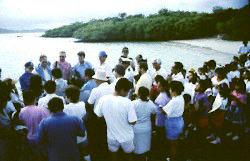 Townspeople of Puerto Villamil
greet Prince Henri of Luxembourg and officials of the Charles
Darwin Foundation and Galapagos National Park Service as they
arrive on Isabela island in 1994.
Townspeople of Puerto Villamil
greet Prince Henri of Luxembourg and officials of the Charles
Darwin Foundation and Galapagos National Park Service as they
arrive on Isabela island in 1994.
On the right, the children's conservation organization, "Club Renacer" (funded by Frankfurt Zoological Society) gives an enthusiastic welcome in song and verse.
The delegation traveled by fishing skiff to Roca Union. Early visitors to Galapagos described seeing thousands of tortoises on the volcanic flanks in this area. Many of the giant tortoises of Galapagos were slaughtered by buccaneers in the 1600s and continued to be consumed as the islands were developed in the 1800s and 1900s. Not a single living adult tortoise was to be seen on this gray day in 1994.
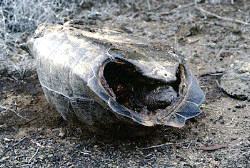
After a rough wet landing amid crashing waves, then a short hike inland, an unmistakable odor assailed the visitors. A dead young tortoise lay in the middle of the trail.
This young tortoise was hacked to death and all the meat left to rot.
This was not the action of a "hungry" islander.
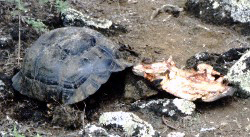
Within 100 meters, another dead tortoise appeared on the lava. This tortoise was cut in half, the meat and legs removed. The bloody plastron (lower shell) lies to the right of the gray carapace.
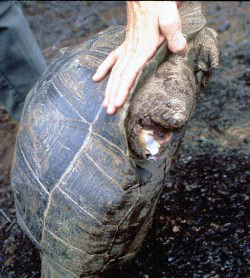
Within 100 meters, another dead tortoise appeared on the lava. This tortoise was cut in half, the meat and legs removed. The bloody plastron (lower shell) lies to the right of the gray carapace.
Remains of the grim harvest continued to appear. Only the feet were removed from this young tortoise.
A souvenir hunter, perhaps?
Certainly not a tourist. This site is not visited by tourists to the Galapagos islands
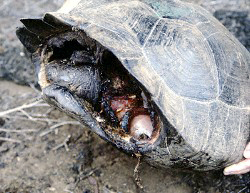
Another tortoise was shoved under a thorny shrub, also with feet removed. It smelled fresh. Retired park guard Pedro Cartagena estimated it had been slaughtered just the day before.
Whose coffee table is now graced by the shriveled souvenirs?
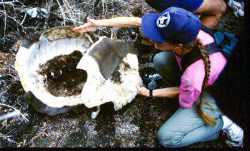 Many old tortoise shells are found
in the area, but the cuts in the carapaces show that the deaths
were not natural.
Many old tortoise shells are found
in the area, but the cuts in the carapaces show that the deaths
were not natural.

Head of a mid-sized Galapagos giant tortoise. Only days earlier, this tortoise roamed freely on Isabela island, chomping on cactus and native grasses.
In the background, the shell of a very large tortoise that had been slaughtered years ago. The dark plates had weathered and fallen away to reveal the white, bony material below. Due to the actions of poachers, such large tortoises are now very rare at Roca Union.
The slaughter of tortoises at Roca Union is not new. What is new is the slaughter of tortoises for no apparent consumptive purpose, or for trophies, or... to send a political message.
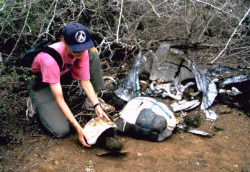
Three different sizes of tortoise shells show that poachers were not selective in their slaughter.
Chronically understaffed and underfunded, the Galapagos National Park Service counts on the good will of the people of Galapagos to conserve the islands' wildlife.
As mounting acts of vandalism against the Park go unpunished by the government of Ecuador and by the residents of Galapagos, the future of these islands is bleak.
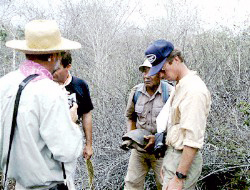 Only dead tortoises had been found after half a day of searching. The
delegation walked back along the silent trail of dead tortoises, toward
the rocky beach.
Only dead tortoises had been found after half a day of searching. The
delegation walked back along the silent trail of dead tortoises, toward
the rocky beach.
Suddenly, Isabela islander and long-time tortoise caretaker don Arnaldo Tupiza rushed up to Prince Henri (right) and the delegation, holding a thrashing, struggling bundle, and shouted triumphantly: A live tortoise, at last!
This page is dedicated to the memory of don Arnaldo Tupiza, namesake of the Arnaldo Tupiza Captive Breeding Center on Isabela island. Don Arnaldo died in an accident during the fishermen's uprising on Isabela island in September, 1995. We like to think that his spirit continues to watch over the baby tortoises of Isabela.